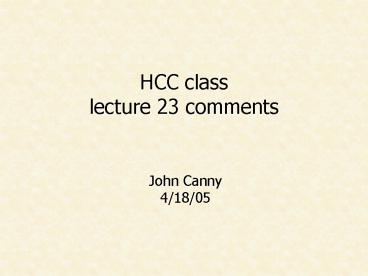HCC class lecture 23 comments PowerPoint PPT Presentation
1 / 9
Title: HCC class lecture 23 comments
1
HCC classlecture 23 comments
John Canny4/18/05
2
Administrivia
- Reminder Project presentations on May 9 and 11.
3
Role and Position
- Role is an intuitive idea it is what the actor
does in the network. - People with similar roles should be
interchangeable in the network, so role analysis
is similar to paradigmatic analysis from
semiotics.
4
Role and Position
- Position is an explicit set of similar actors.
These actors share the same set of relations with
others. - Role is the pattern of relations between the
actors. - Therefore role is the more abstract, portable
notion. E.g. Mother, child, manager, travel
agent, can be defined by particular sets of
relations between these actors and certain other.
- The position of father in a particular network is
the set of actors who act as fathers to others in
the network.
5
Equivalence
- Regular equivalence Actors are equivalent if
they have ties to others with the corresponding
roles. - e.g. A has the role of mother because of ties to
B, C, D, who have the role of son or
daughter.
6
Equivalence
- Regular equivalence Actors are equivalent if
they have ties to others with the corresponding
roles. - e.g. A has the role of mother because of ties to
B, C, D, who have the role of son or
daughter.
7
Equivalence
- Structural equivalence is an easy notion to deal
with, since it depends on the actual identities
of the neighbors. E.g. correlations or euclidean
distance comparison can be used. - Regular equivalence is a more useful idea, but is
trickier because its definition is recursive One
must know the neighbors roles before assigning a
new role. - Regular equivalence is an active area of
research, although some solutions exist.
8
Hierarchical clustering
- One natural way to build a regular equivalence
relation is to hierarchically cluster the data - Actors are clustered together if they have the
similar relations to other actors (structural
equivalence). - Then we repeat the clustering on the abstracted
graph (actors are clusters from the previous
step), etc - In this way, neighbors are labeled with roles
from the previous step.
9
Discussion Topics
- T1 How do role and position relate to
communities of practice? Are such communities
actually positions in a network, or do they
have internal roles, or both? - T2 The readings argue that its often helpful to
use typed ties (e.g. a tie that is explicitly
labeled mother). By using example networks that
you know, critique this idea. Can ties always be
typed? Or are there ties whose type may not be
known a priori?

